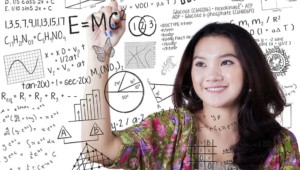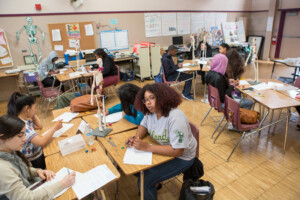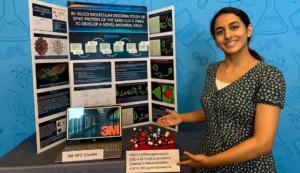Why Math and STEM Education is a Social Justice Issue

By: Dr. Gina Cherkowski
The Fourth Industrial Revolution requires that today’s youth are equipped with the skills, tools and mindsets needed to think creatively, leverage technology wisely and solve wicked problems collectively. Answering the call, leading education systems around the world are striving to integrate STEM, STEAM and Maker learning experiences into students’ daily lives. Globally, we are moving away from an antiquated industrial approach toward one more suitable for today’s digital natives.
Recent thinking moves beyond the basic definition of STEM as Science, Technology, Engineering and Math toward positioning STEM/STEAM as an integrated learning experience that leverages knowledge from traditionally siloed subjects such as math, science and even art and the humanities, in order to creatively solve complex human problems while employing new technologies and developing innovative thinking capacities. Applying “soft skills” such as creativity, collaboration, communication and emotional intelligence to technical STEM knowledge unlocks the potential for purposeful and impactful innovation.
There is no question that technology is rapidly changing the way people live, work, play, communicate and even the way we think. Given the unprecedented rate of change in technological advancements, experts around the globe are in strong agreement that digital skills are a mandatory literacy required for the youth of today and tomorrow. According to the World Economic Forum, countries who prioritize digital literacy will aptly prepare students for the job market of the future.
However, even though it is necessary to equip students with technology skills so they are prepared to participate, collaborate and communicate in our highly networked, global environment, there is another element of STEM that I urge schools not to overlook: we must not forget to focus attention on the “M” for Math.
Mathematical Literacy and the STEM Pipeline
Mathematics is a human endeavor, created so we can better understand and engage with our world. Having a mathematically literate citizenry is imperative for many critical economic, social and human reasons.
The urgency of mathematical knowledge has been linked to pivotal events and epic occurrences. When Sputnik took orbit decades ago, it marked an exciting time for innovation around the world, igniting the launch of the space race. To many it was the Golden Age of math and science. All around the world there was a renewed push to equip students with the ‘right’ math and science knowledge.
Enter the “Math Wars.” With the growing global imperative to increase the number of students who were mathematically literate, different opinions gained traction regarding “what math” and “how to best teach it.” As a legacy, the pendulum has been swinging back and forth for decades with little success. To advance forward with an effective and sustainable solution for this decades old issue, I suggest a look toward advancements in neuroscience and brain-based learning. With new technologies and the emergence of epigenetics and neuroimaging, science is continuously shedding light on how diverse brains think, learn and understand the world around them. Mathematical literacy for all requires letting go of the “one-size-fits-all” recipe, with its DNA in the Industrial Revolution and adopting a personalized approach that focuses both on fluency of facts and on deep, conceptual understanding, thus equipping youth with the ability to think mathematically and solve complex problems.
By understanding how diverse human brains work and what humans need in order to learn and make sense of new information and ideas, research tells us that personally connecting knowledge in meaningful ways is critical for learning math. One of the main reasons previous approaches have been unsuccessful at engaging all students in math, is that they have been too heavily laden with the verbal linguistic signs and symbols that have served as barriers to the majority of students. Humans, as analogic beings, learn best through stories, metaphors and visual models – precisely what most North American math classes often neglect. The fallout of focusing on semiotics (the signs and symbols) is that far too many talented students are continually filtered out of math.
Math is a Social Justice Issue: Who Gets to Know?
Disparities in mathematical literacy cut across racial, gender and socioeconomic lines. It is a consistent narrative that the vast majority of students being filtered out of mathematics―most often, when struggling students become disengaged because they feel they “can’t do” math and no longer see themselves as capable of being good math students―are underprivileged, underserved and underrepresented youth. Math is, and will continue to be, charged with the perpetuation of social and economic stratification, divisiveness and cultural inequity until we change this sad equation.
Traditionally, math has been linked to vocational and educational opportunities and importantly, to earning potential over one’s lifetime. It is even connected to social and emotional well-being, volunteerism and even to job satisfaction. Those who are fortunate enough to be mathematically literate are therefore afforded with the benefits that come with this privileged status, including the ability to attain better, more satisfying and higher paying jobs. In sum, filtering students out of math can impact the trajectory of their life.
Today, it is widely known and accepted that a nation’s health, wealth and vitality is inherently linked to its ability to produce a citizenry literate in science, technology and engineering. As such, STEM is an increasingly prevalent global agenda. Given that mathematical knowledge remains the “gatekeeper” for access into the high-demand STEM pipeline, we must ensure our youth have the math skills they need to be able to participate in today’s rapidly-changing, technology-driven global economy. Filtering kids out of math means filtering them out of STEM.
To advance the domains of math and STEM, all voices are required. Cultural, ethnic and gender diversity has been linked to higher innovation outcomes, a key driver of STEM. According to a 2007 McKinsey report, ethnically diverse workforces financially outperform non-diverse workforces by 35 percent and a gender diverse workforce yields a 15% increase in financial output. The report further suggests that an astounding $28 trillion could be added to the global GDP if women played an identical role in the workforce to men, adding that the fastest-moving countries to advance women and girls stand to boost their GDP by $12 trillion by 2025. Diversity in math and STEM is increasingly critical, as diverse perspectives and ways of knowing in math and STEM are required to further knowledge in these traditionally hegemonic domains. Diversity is an essential element of a society that is democratic and just.
Add up all this evidence and you come to one conclusion: Math is a social justice issue.
Knowing and understanding math is no doubt important for the advancement of the STEM and innovation imperatives, but it is also critical for humanity. Mathematical knowledge has been intrinsically linked to creating healthy, community-oriented citizens and empowered change agents. For example, recent reports connect math to job satisfaction and more critically, to attaining full and active community volunteerism, as mathematical literacy, especially early math, has been linked to factors required for leading a full and productive life as a critical, engaged global citizen. Unequal access to math means unequal access to societal and economic participation.
Opportunity for STEM, STEAM and Maker
There are many reasons that students continue to underperform in math, but the latest neuroscience shows that all kids can learn it. One common issue for struggling learners is that there are gaps between the signs and symbols of math and the meaning of math―what the algorithm, procedure or concept means. In order to connect meaning to signs and symbols, we need to understand who is learning, how they learn, and what previous knowledge we can connect to new mathematical ideas. By engaging kids in hands-on learning experiences where they make, play, test, fail and apply mathematical ideas, we can make strong neuroconnections for many of our struggling learners. By adding real world, meaningful context through stories, images, actions, movement and/or visual models, we can leverage students’ innate visual-spatial and temporal abilities and make deep meaningful connections to math for students who traditionally seem to struggle in the classroom.
STEM, STEAM and Maker learning experiences are ways we can achieve these outcomes and make mathematical ideas and critical concepts make sense to students. Additionally, by having students explore mathematical ideas by solving problems, they are free to access and leverage their own unique ways of knowing, including cultural, ethnic and personal learning propensities.
Today’s teachers are savvy to the diverse needs of their students. They work tirelessly to keep up with technology, equipping themselves with the latest practice and pedagogical strategies to best prepare their students to be successful 21st century contributors and difference-makers. Along these lines, some of the most common questions teachers ask me revolve around how to identify the math in STEM, STEAM and Maker. I suggest it is already there―math is all around us, in every product, innovation, piece of clothing, art, new technology―but remains unseen by the vast majority. So, we have to train our minds to see it.
However, the bigger question might be, “how can teachers meaningfully mathematize STEM, STEAM and Maker activities in ways that engage all students, fostering a love of mathematical learning while equipping them with the key competencies?” One solution is to use technology as a way to showcase learning, rather than to check the technology box. Instead of coding for the sake of learning to write code, I suggest “coding for a purpose.” One specific project that I particularly love was designed to develop conceptual understanding and procedural fluency with regard to operations with integers. This comprehensive STEAM project involved understanding integer operations, creating a story to reflect learning, designing the stage for the coded narrative, and culminated with the students each coding solutions to traditional mathematical integer problems. When given a standardized test afterwards, students’ scores increased, indicating they were successfully able to transfer their knowledge from the hands-on STEAM project into a traditional assessment format.
Through this project, by design, students gained technical skills, increased creative capacities, and critical problem solving skills, in addition to basic math skills. Instructors also observed a high level of interest from diverse students and not just students who self-identified as traditionally being good at math. Whether schools try a project much like this one, or develop their own ideas that blend opportunities for students to develop both soft skills and technical skills, this is a clear pathway to making learning more relevant, getting all students engaged in the process, and fulfilling our duty to prepare all students to meaningfully participate in the workforce and society. This is the power of integrating learning math in a real world setting though STEM/STEAM.
Educators, It Starts With Us
The specific techniques and strategies we use for teaching math and getting students into the STEM pipeline are one part―and a very important part―of this process. However, it all starts with our acknowledgement that math is a social justice issue; that every child deserves to know math and that it can make the difference between exposure to lifelong opportunity or a world that’s much more limited and closed off to any number of possibilities. The good news is every educator can make a difference and when we fully embrace our role as difference-makers, we can change the world for our students and the future generations who will benefit from what they achieve. Math is a social justice issue and I urge us all to take on the cause!
For more, see:
- STEM Projects in Active Learning Spaces at Samueli Academy
- How to Introduce your School to STEM: The 5 Most Important Factors for Success
- Ensuring Readiness for All Through Math Literacy
Dr. Gina Cherkowski is the Chief Education Officer for EdgeMakers and the Founder & Director of Learning of STEM Learning Lab. Gina has developed programs for teachers and students that have advanced the mission to ensure all students have access to high-quality STEM learning experiences so they are aptly prepared for our technology-driven, dynamic world. Follow Gina on Twitter @gcherkowski.
Stay in-the-know with innovations in learning by signing up for the weekly Smart Update.







Sally
Impressive and practical. Innovation and resources much needed in struggling economies to raise STEM importance awareness. As a STEM/STEAM enthusiast in Africa, we have unique challenges which we can overcome if we realise STEM is a game changer.
Thank you Dr. Gina
Mel Wahl
Sadly there are things in the world that are complex and understanding that complexity requires a lot of individual effort/work. No technology can produce deep understanding without a student respecting the difficulty of the task before them and then having a desire to know more but understanding the level of dedication and hard work that that requres.
Golfers can watch video till hell freezes over but only daily "drill" is what creates that command of subject in them.
Parul
Thanks for sharing the valuable information with us.
Learn Math and STEM Education is very important for a student. STEM education and math teach students how to solve problems by using their critical thinking skills. By engaging in STEM learn experiences and math practices, students learn how to examine problems and then create a plan to solve them.
Sumita Mukherjee
Such a great blog!! Advancement and assets are much required in striving economies to raise STEM significance mindfulness. As STEM/STEAM educators in UK, USA, and India, we have one-of-a-kind difficulties which we can survive on the off chance that we understand STEM is a distinct advantage towards the young generation to boost creativity and problem-solving skills.